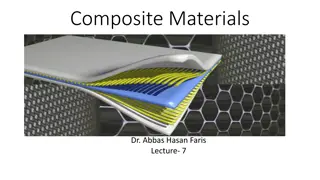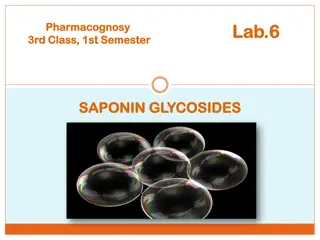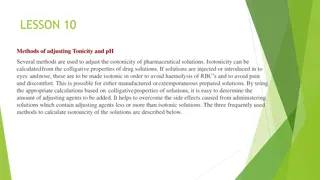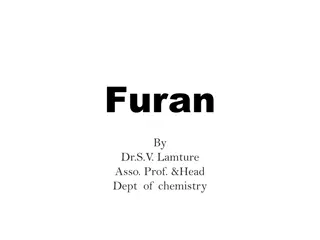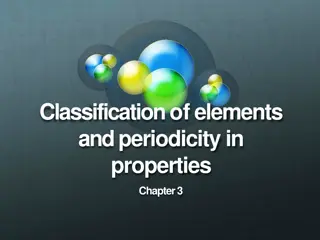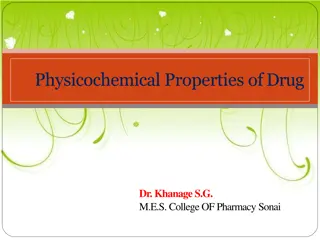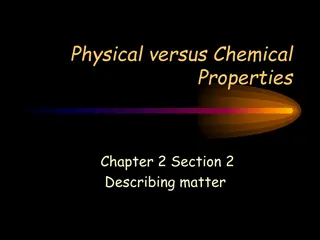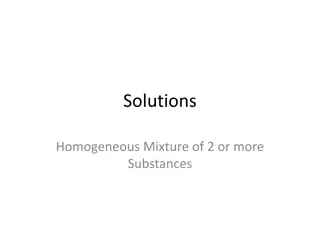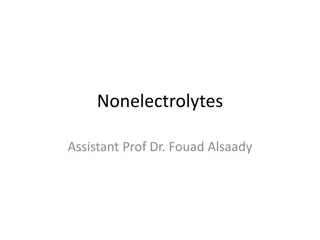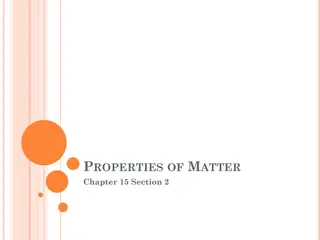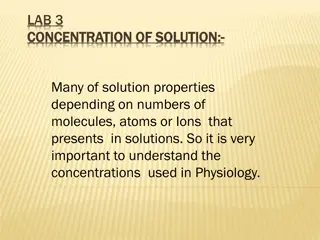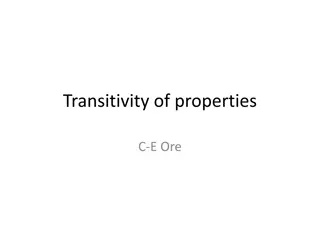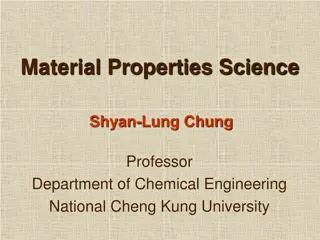Colligative Properties in Solutions
Colligative properties in solutions depend on the total concentration of solute particles present, impacting properties such as boiling point elevation, freezing point depression, vapor pressure lowering, and osmotic pressure. Boiling point elevation is directly proportional to the number of solute particles, while freezing point depression decreases the freezing point compared to the pure solvent. These properties play a crucial role in various applications in chemistry and biology.
Download Presentation

Please find below an Image/Link to download the presentation.
The content on the website is provided AS IS for your information and personal use only. It may not be sold, licensed, or shared on other websites without obtaining consent from the author.If you encounter any issues during the download, it is possible that the publisher has removed the file from their server.
You are allowed to download the files provided on this website for personal or commercial use, subject to the condition that they are used lawfully. All files are the property of their respective owners.
The content on the website is provided AS IS for your information and personal use only. It may not be sold, licensed, or shared on other websites without obtaining consent from the author.
E N D
Presentation Transcript
COLLIGATIVE PROPERTIES - Depends on the collective effect of the number of solute particles but not on the nature of the solute. 1. Boiling point elevation Tb = kbm 2. Freezing point depression Tf = -kfm 3. Vapor pressure lowering Raoult s law Pa = AP A 4. Osmotic Pressure = MRT = n RT V
Colligative Properties Those properties of a solvent (i.e. vapor pressure lowering, freezing point depression, boiling point elevation, osmotic pressure) that depend on the total concentration of solute particles present. NOTE: i = van t Hoff factor, which is determined experimentally and represents the degree of dissociation of the solute in the solvent. Table of Molal Boiling Point Elevation/Freezing Point Depression Constants for Various Solvents Solvent Normal BP ( C) Kb ( C/m) H2O 100.0 Benzene, C6H6 80.1 Ethanol, C2H5OH 78.4 CCl4 76.8 Chloroform, CHCl3 61.2 3.63 Normal FP ( C) Kf ( C/m) 0.52 0.0 1.86 2.53 5.5 5.12 1.22 -114.6 1.99 5.02 -22.3 29.8 -63.5 4.68
Colligative Properties 1. Boiling Point Elevation The increase in boiling point of a solution relative to that of the pure solvent is directly proportional to the number of solute particles per mole of solvent molecules. That is, Tb = i Kb m where Tb= increase in boiling point relative to that of the pure solvent, Kb is called the molal boiling point elevation constant, and m = molality of the solution.
BOILING POINT ELEVATION - indepth Normal boiling point of a pure liquid or solution is the temperature at which the vapor pressure is at 1 atm. A dissolved solute will reduce the vapor pressure; the temperature of the solution must be increased in order to induce boiling, the boiling point is therefore higher than pure solvant. Tb = iKb m NOTE: The vapor pressure curve of a dilute solution lies below that of the pure solvent therefore the P is the decrease of vapor pressure at Tb (boiling point). Tb is the change in temperature necessary to hold the vapor pressure at 1 atm ( Tb is increase in boiling point caused by addition of solute to pure solvant). The following slide gives the mathematical derivation.
- P1 = slope Tb AT Low [concentration]: Tb = - P1 = x1P1 = 1 n2 S S S n1 + n2 constant S = property of pure solvant (independent of solute) AT [Very dilute]: n1>>n2 Tb = 1 n2 = 1 m2/MM2 solute = m2 S n1 S m1/MM1 solvent = m1 Kb = Boiling point elevation constant = m1 1000 g/kg * S Tb = Kb m2/MM2 m1/1000 g/kg m = moles solute/ kg solvent = Kbm
Colligative Properties 2. Freezing Point Depression Like the boiling point elevation, the decrease in freezing point of a solution relative to that of the pure solvent is directly proportional to the molality of the solute. That is, Tf = iKf m where Tf= decrease in freezing point relative to that of the pure solvent, Kf is called the molal freezing point depression constant, and m = molality of the solution.
Lecture Questions: 1. When 5.5 g of biphenyl (C12H10) is dissolved in 100g of benzene, the boiling point increases by 0.903 C. Calculate Kb for benzene. (Biphenyl M.M. = 154.2 g/mol) 2. When 0.494g of K3Fe(CN)6 is dissolved in 100.0 g of H2O, the freezing point is found to be -0.093 oC. How many ions are present for each formula unit of K3Fe(CN)6 dissolved?
3. mole fraction calculation from gas laws unit) Vapor Pressure Lowering (similar to Psolvent = solvent Ppure known as Raoult s Law where Ppure = vapor pressure of the pure solvent, solvent = mole fraction of the solvent, and P is the vapor pressure of the solvent in the solution.
RAOULTS LAW PA = XAPA A = solvent B = solute PA = vapor pressure of A in the solution XA = mole fraction of A PA = vapor pressure of pure solvent PA must be non zero and the solute must be nonvolatile and temperature is constant. Raoult s law is for ideal solutions PA ideal PA + - The solute attracts the solvent molecules reducing the solvents escape into the vapor phase. 0 XA 1 positive deviation = non ideal solutions negative deviation = vapor pressure is lowered
4. Osmotic Pressure The net movement of solvent molecules from a less concentrated solution into a more concentrated one is known as osmosis. The pressure required to prevent osmosis is known as the osmotic pressure (defined by the variable ) and can be calculated as: = i MRT where M = Molarity, R = 0.08206 L atm K-1 mol-1, and T = Temperature (K).
OSMOSIS Osmosis is the phenomenon of solvent flow through a semipermeable membrane to equalize the solute concentration on both sides of the membrane. Osmotic pressure is a colligative property of a solution equal to the pressure that, when applied to the solution just stops the flow of solute. 1. Solvent flows in and out of the membrane but the solute does not. 2. The volume of the solution inside the membrane increases, stretching the membrane, until equilibrium is reached. 3. The pressure on the solution side of the membrane is greater than atmospheric pressure on the surface of the pure solvent. 4. The different between these two pressures is osmotic pressure.
Lecture Questions: 1. At 25 C, the vapor pressure of C6H6 is 0.1252 atm. When 10.00 g of an unknown volatile substance is dissolved in 100.0 g of benzene, the vapor pressure of the solution, at 25 C, is 0.1199 atm. Calculate the molar mass of the solute. 2. What is the osmotic pressure at 25 C of an isotonic saline solution that contains 0.900 g NaCl in 100 mL of aqueous solution? Assume i is ideal. 3. At 25 C, the freezing point of a NaCl aqueous solution is -0.406 C. Calculate the osmotic pressure this solution has on a semi-permeable membrane if the concentration of the solution is equivalent to the molality.
Workshop on boiling point elevation: 1. When a 11.2 G sample of sulfur was dissolved in 40.0 g of CS2, the boiling point elevation of CS2 is 2.63 C. What is the molecular weight of sulfur in the solution? What is the formula of molecular sulfur? 2. Lanthanum (III) chloride, LaCl3, like many soluble salts, completely dissociates into ions in dilute aqueous solutions. H2O LaCl3(s) La3+(aq) + 3 Cl-(aq) Suppose 0.2453 g of LaCl3 will dissolve in 10.00 g of H2O, what will be the boiling point of the solution at 1 atm?
Workshop on Colligative Properties 1. Determine the vapor pressure of a solution of 92.1 g of glycerin, C3H5(OH)3, in 184.4 g of ethanol at 40 C. The vapor pressure of pure ethanol is 0.178 atm at 40 C, and glycerin is essentially nonvolatile. 2. Find the boiling point of a solution of 92.1 g of iodine in 800.0 g of chloroform. 3. Calculate the freezing point of a solution of 0.724 g of calcium chloride in 175 g of water, assuming complete dissociation by the solute. 4. Determine the osmotic pressure of a solution with a volume of 0.750 L that contains 5.0 g of methanol in water at 37 C. 5. List the following aqueous solutions in order of their expected freezing points: 0.050 m CaCl2, 0.15 m NaCl, 0.10 m HCl, 0.050 m HC2H3O2, and 0.10 m C12H22O11.
Workshop continue: 6. A solution of 4.00 g of a nonelectrolyte dissolved in 55.0 g of benzene is found to freeze at 2.32 C. What is the molar mass of this compound? 7. 0.500 L of an aqueous solution that contains 10.0 g of hemoglobin has an osmotic pressure of 5.9 torr at 22 C. What is the molar mass of hemoglobin? 8. A solution of 35.7 g of a nonelectrolyte in 220.0 g of chloroform has a boiling point of 64.5 C. What is the molar mass of this compound? 9. An organic compound has a composition of 93.46% C and 6.54% H by mass. A solution of 0.090 g of this compound in 1.10 g of camphor melts at 158.4 C. The melting point of pure camphor is 178.4 C, and its freezing point depression constant is 37.7 C m-1. What is the molecular formula of the solute?
COLLOIDS Colloidal Suspensions are heterogeneous mixtures. A dispersion of particles of one substance throughout another substance or solution. Tyndall Effect The scattering of light by colloidal-size particles usually around 1 x 103 pm to 2 x 105 pm (picometers). Some common materials which exhibit the Tyndall effect would be soluble starch in water or fog.
Types of COLLOIDS Continous Phase Phase Dispersed Name Example Gas Gas Liquid Liquid Liquid Solid Solid Solid Liquid Solid Gas Liquid Solid Gas Liquid Solid Aerosol Aerosol Foam Emulsion Sol Foam Gel Solid sol Fog, mist Smoke Whipped Cream Mayonnaise (oil dispersed in water AgCl(s) dispersed in H2O Pumice, plastic foams Jelly, Opal (mineral with liquid inclusions) Ruby glass (glass with dispersed metal)
Hydrophillic Colloid A colloid in which there is a strong attraction between the dispersed phase and the continuous phase (water) Hydrophobic Colloid A colloid in which there is a lack of attraction between the dispersed phase and the continuous phase (water) Coagulation The process by which the dispersed phase of a colloid is made up to aggregate and thereby separate from the continuous phase
ASSOCIATION COLLOID Micelle A colloidal-size particle formed in water by the association of molecules or Ions that each have a hydrophobic and hydrophillic end. Sodium Lauryl Sulfate: CH3(CH2)11OSO3- Na+ sterate ion: CH3(CH2)16COO- Na+






